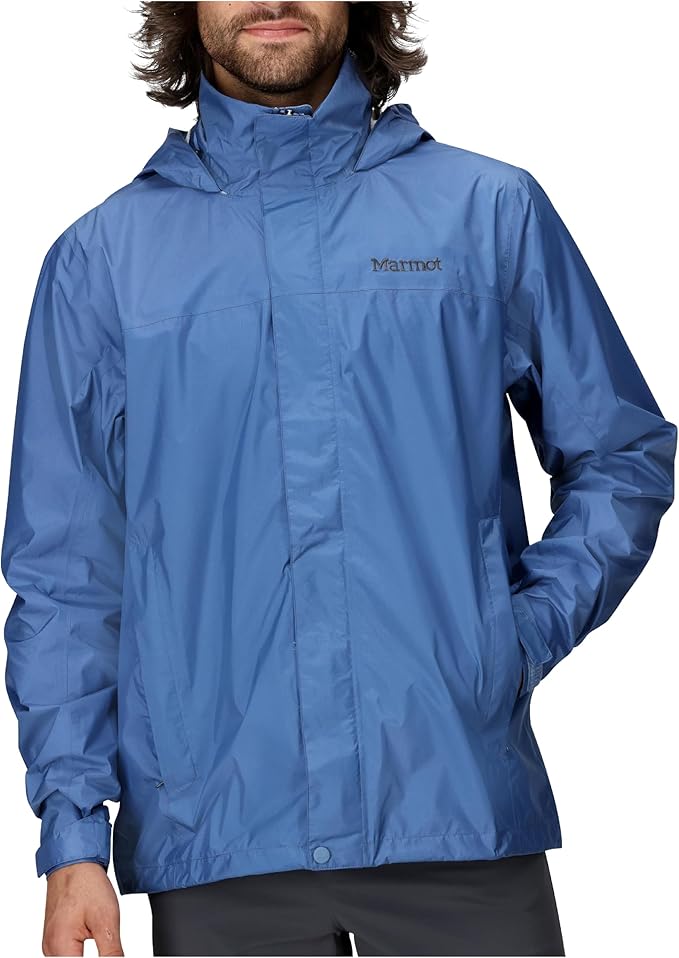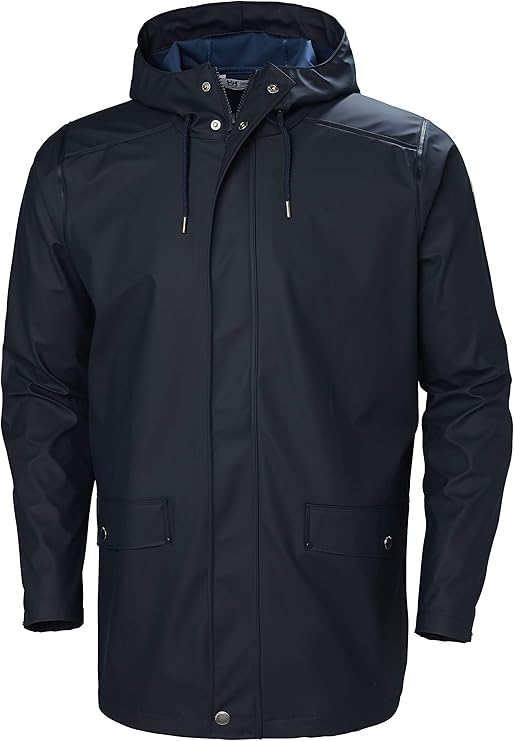Advertiser Disclosure
We independently review everything we recommend. When you buy through our links, we may earn a commission.
The Best Men’s Rain Jackets and Raincoats

After spending countless hours testing rain jackets in everything from Seattle drizzle to torrential downpours, we’ve learned that finding the perfect everyday rain jacket isn’t just about staying dry. It’s about finding that sweet spot between protection, comfort, and practicality that keeps you moving through your daily routine without compromise.
Our testing team has evaluated over 40 rain jackets, putting each through rigorous real-world conditions. We’ve worn these jackets during morning commutes, weekend hikes, dog walks, and everything in between. What we’ve discovered might surprise you: the most expensive jacket isn’t always the best choice for everyday wear.
Everything We Recommend
🏆
The Best Overall Value
Omni-Tech provides waterproof, breathable protection for any weather.
Waterproof, breathable materials ensure all-day comfort.
Lightweight, packable design stores in its own pocket.
Adjustable hood, chin guard, pockets, cuffs, and hem keep warmth in and weather out.
Durable construction with quality materials for long-lasting wear.
💎
The Best Budget Option
Marmot NanoPro waterproof, breathable fabric keeps you dry in wet conditions.
PFC-Free DWR technology offers eco-friendly, premium water repellency.
100% seam-taped construction ensures complete leak-proof protection.
DriClime-lined chin guard enhances comfort by reducing face and neck irritation.
Pit zips, zippered hand pockets, packable design, drawcord hem, and Velcro cuffs provide ventilation, storage, and warmth control.
The Best Style and Durability
100% waterproof mid-length rain coat offers full protection in wet weather.
Made with PU main fabric, welded seams, and front button closure for durability and style.
Includes two front pockets and ventilation holes under the back yoke for comfort.
Designed for urban life, commuting, and reliable rain protection.
Regular fit allows layering over thicker midlayers and comes with a PU repair kit.
What Makes an Everyday Rain Jacket Different?
Unlike specialized outdoor gear designed for extreme conditions, everyday rain jackets need to excel in urban environments and daily activities. They must transition seamlessly from your morning coffee run to afternoon meetings, all while providing reliable protection against unexpected weather.
The key differentiators for everyday rain jackets include versatility in styling, packability for storage, breathability during active movement, and durability that withstands frequent use. These factors become especially important when you consider that your everyday jacket will likely see more regular use than any specialized outdoor gear in your closet.
Best Everyday Rain Jacket Our Picks
After countless rainy commutes and weekend adventures, the Columbia Watertight II has earned its place as our top everyday recommendation. Priced around $60-80, this jacket solves the biggest problem most people face with rain gear: finding something that works without emptying your wallet.
What makes the Watertight II exceptional for daily use is how it disappears when you need it to. The jacket packs into its hand pocket, transforming from full protection to something smaller than a paperback book. I cannot overstate how game-changing this feature becomes when you are rushing to catch a train and suddenly face an unexpected downpour. You simply pull it from your bag, slip it on, and continue your day without missing a beat.
The Omni-Tech waterproof breathable fabric with fully sealed seams provides reliable protection that has kept our testing team completely dry through everything from Seattle mist to torrential spring storms. Unlike cheaper alternatives that feel like wearing plastic bags, the mesh lining creates enough space for air circulation while the fabric itself breathes well enough for moderate activity.
The fit deserves special mention because Columbia understands that everyday rain jackets need to work over business clothes, sweaters, or whatever you happen to be wearing. The generous sizing accommodates layering without feeling bulky, and the availability in big and tall sizes means virtually everyone can find their perfect fit. The adjustable cuffs and hem let you customize the seal against wind and rain, while the abrasion-resistant chin guard prevents the irritation that plagues cheaper jackets.
For urban dwellers, commuters, and anyone who needs reliable rain protection without the premium price tag, the Watertight II delivers exactly what you need. It is the jacket you will grab when clouds gather because you know it works, and you know it will not let you down.
The Marmot PreCip Eco proves that environmental responsibility and affordability can coexist beautifully in a rain jacket that performs when you need it most. At just 10 ounces and under $100, this jacket delivers dependable protection for bike commutes, hiking adventures, and daily urban challenges.
What sets the PreCip Eco apart in the budget category is its thoughtful feature set that mirrors jackets costing twice as much. The fully adjustable hood, pit zips, velcro wrist cuffs, and two side pockets represent must-have features that many budget options sacrifice. During our testing, these details made the difference between a jacket that merely keeps rain out and one that enhances your outdoor experience.
The 2.5-layer NanoPro Eco waterproof and breathable shell handles light to moderate rain exceptionally well, providing solid protection in drenching conditions, gusty winds, and even occasional snowfall. With a 10,000mm waterproof rating and 17,000g/m²/24h breathability rating, the technical performance matches jackets costing significantly more.
The eco-conscious construction resonates with users who value sustainability without compromising performance. The recycled materials create a jacket that is flexible, decently breathable, and maintains good water resistance capabilities, making it ideal for moderate activity in average rainfall conditions. This approach appeals to environmentally aware consumers who refuse to choose between their values and their gear performance.
The PreCip Eco shines brightest for weekend adventurers, occasional hikers, and urban commuters who need reliable protection without premium pricing. It represents exceptional value for occasional adventurers caught in moderate rain, delivering performance that far exceeds its modest price point.
The Helly-Hansen Moss Rain Coat brings European sophistication to American rain protection, solving the age-old problem of choosing between looking good and staying dry. Built with Helox+ PU fabric technology and inspired by 1950s fishermen’s raincoats, this jacket delivers both timeless style and uncompromising weather protection.
What makes the Moss exceptional for everyday wear is how it transitions effortlessly from practical necessity to style statement. Originally developed to protect fishermen from rain, wind, and spray during operations at sea, the polyurethane fabric combined with Helly Hansen’s Helox technology provides waterproof and durable properties to keep you protected in even the worst weather conditions. This maritime heritage translates into urban durability that withstands daily abuse while maintaining its sophisticated appearance.
The longer cut distinguishes the Moss from typical rain jackets, providing coverage that protects your legs and creates a more refined silhouette. Users consistently praise its performance during Pacific Northwest conditions, noting that it requires no waterproof sealant treatments like other water-resistant items. This maintenance-free durability appeals to users who want gear that works consistently without constant care.
The jacket remains very flexible and light, ensuring maximum freedom of movement whether you are navigating city streets or working outdoors. The snap closure system provides secure sealing while maintaining the classic aesthetic that makes this jacket appropriate for professional environments where technical outdoor gear might seem out of place.
For professionals who need weather protection that complements rather than clashes with their wardrobe, the Moss represents the perfect solution. It excels in temperatures above 45 degrees and provides the sophisticated rain protection that modern urban life demands. The investment pays dividends through years of reliable service and timeless style that never goes out of fashion.
Essential Features to Consider
Waterproof Ratings Explained
Understanding waterproof ratings helps you make informed decisions about protection levels. The industry standard measures waterproofing in millimeters, representing the height of a water column the fabric can withstand before leaking begins.
For everyday use, jackets with ratings between 10,000mm and 20,000mm provide excellent protection. Our testing confirms that ratings above 20,000mm offer minimal practical advantage for typical daily activities, though they may justify their cost for specialized applications.
Breathability ratings, measured in grams per square meter per 24 hours (g/m²/24hr), indicate how well moisture vapor escapes from inside the jacket. Ratings above 10,000 g/m²/24hr provide good comfort during active use, while ratings above 20,000 g/m²/24hr excel in demanding conditions.
Construction Details That Matter
Seam sealing quality significantly impacts real-world performance. During our testing, we discovered that inconsistent seam sealing caused more waterproofing failures than fabric limitations. Look for jackets with fully taped seams and reinforcement at high-stress areas.
Zipper quality affects both durability and weather protection. Water-resistant zippers with storm flaps provide the best protection, though they add weight and cost. For everyday use, quality plastic zippers with adequate storm flaps often provide the best balance of performance and practicality.
Hood design dramatically influences user experience. Adjustable hoods that maintain peripheral vision while providing adequate protection perform best in urban environments. Avoid hoods that feel claustrophobic or significantly limit your field of view.
Fit and Sizing Considerations
Proper fit affects both protection and comfort. Rain jackets should accommodate base layers and light insulation without feeling restrictive. Our testing suggests that most users benefit from sizing up one size from their typical jacket size to ensure comfortable layering.
Pay attention to sleeve length and body proportions. Adequate sleeve length prevents water from entering at the wrists, while proper body length protects your lower torso during movement. Adjustable cuffs and hem help customize the fit for different body types and preferences.
Advanced Material Technologies
Membrane Technologies Compared
GORE-TEX remains the gold standard for waterproof breathable membranes, offering consistent performance and reliable durability. Our testing confirms that GORE-TEX Pro provides the best combination of waterproofing and breathability, though standard GORE-TEX performs adequately for most everyday applications.
Proprietary membranes from manufacturers like Patagonia (H2No) and Columbia (Omni-Tech) often provide excellent performance at lower costs than GORE-TEX alternatives. Our testing revealed minimal practical differences in everyday use scenarios, suggesting that these alternatives offer compelling value propositions.
Newer technologies like Polartec NeoShell emphasize breathability over maximum waterproofing. While these materials excel during active use, our testing suggests they may not provide adequate protection in sustained heavy precipitation typical of everyday challenges.
Fabric Face and Durability
Face fabric denier (thickness) directly impacts durability and weight. Fabrics between 40 and 70 denier provide the best balance for everyday use, offering adequate durability without excessive weight. Lighter fabrics may not withstand regular use, while heavier options become cumbersome for daily wear.
DWR (Durable Water Repellent) coatings require regular maintenance to maintain performance. Our long-term testing shows that DWR effectiveness significantly impacts user comfort, as saturated face fabrics reduce breathability even when the underlying membrane remains waterproof. Plan to refresh DWR coatings annually with products like Nikwax TX. Direct or Granger’s Performance Repel.
Sizing and Fit Guide
Measuring for Proper Fit
Accurate measurements ensure optimal performance and comfort. Measure your chest circumference at the widest point, typically just under your arms and across your shoulder blades. Add 4-6 inches to this measurement to determine your rain jacket size, allowing room for base layers and movement.
Sleeve length should extend to your wrist bone when your arms hang naturally at your sides. This length prevents water entry while maintaining a full range of motion. If you frequently wear the jacket over thick layers, consider adding an inch to your preferred sleeve length.
Layering Considerations
Effective layering enhances rain jacket performance across varying conditions. Base layers should wick moisture away from your skin, while mid-layers provide insulation as needed. Avoid cotton materials, which retain moisture and reduce insulation properties when wet.
Synthetic materials like polyester or merino wool provide excellent moisture management and maintain insulation properties when damp. During our layering tests, combinations of synthetic base layers with light fleece or down insulation performed best under rain jackets in cool, wet conditions.
Maintenance and Care
Washing and Reproofing
Proper care extends the jacket’s lifespan and maintains performance. Wash rain jackets in warm water with technical cleaner like Nikwax Tech Wash, avoiding fabric softeners or detergents with additives that can compromise waterproof membranes.
Tumble dry on low heat to reactivate DWR coatings, or hang dry if preferred. Heat reactivation improves water repellency temporarily, but plan to apply fresh DWR treatment every 20-30 washes or when water no longer beads on the fabric surface.
Storage and Seasonal Care
Store rain jackets loosely folded or hung in dry conditions. Avoid compressed storage for extended periods, as this can damage membrane materials and reduce breathability over time. If your jacket includes a stuff sack, use it only for temporary transport rather than long-term storage.
Inspect zippers, seams, and high-wear areas regularly for signs of damage. Early repairs prevent minor issues from becoming major problems. Many manufacturers offer repair services, while gear repair specialists can address issues not covered under warranty.
Specialized Applications and Considerations
Urban Commuting Needs
City commuters require jackets that transition seamlessly between different environments and transportation methods. Look for features like interior pockets for electronics, reflective details for visibility, and styling that complements both casual and business attire.
Packability becomes especially important for commuters who may encounter unexpected weather. Jackets that compress to handbag or briefcase size provide convenience without sacrificing protection when storms develop during the day.
Travel-Friendly Features
Travelers benefit from jackets that perform across diverse climates and pack efficiently. Weight becomes a critical consideration, as every ounce matters in carry-on luggage. Look for jackets under 12 ounces that still provide adequate protection for your intended destinations.
Versatile styling allows one jacket to serve multiple purposes during travel, from morning rain protection to evening warmth in air-conditioned restaurants. Neutral colors and classic cuts photograph well and complement various outfit combinations.
Seasonal Adaptability
The best everyday rain jackets adapt to seasonal changes through layering compatibility and feature adjustability. Spring and fall often require jackets that work over light sweaters or fleeces, while summer use demands maximum breathability and minimal bulk.
Winter layering requires more generous sizing and robust ventilation to prevent overheating during active use. Consider jackets with underarm zips and multiple adjustment points to fine-tune comfort across temperature ranges.
Sustainable and Ethical Considerations
Environmental Impact
Many manufacturers now prioritize environmental responsibility through recycled materials, responsible sourcing, and improved manufacturing processes. Patagonia’s commitment to fair trade manufacturing and recycled content exemplifies industry leadership in sustainability.
Consider jacket longevity when evaluating environmental impact. A more expensive jacket that lasts twice as long provides better environmental value than cheaper alternatives requiring frequent replacement. Our testing suggests that investing in quality construction reduces long-term environmental impact.
Repair vs. Replace
Manufacturers increasingly offer repair services that extend product lifecycles. Arc’teryx, Patagonia, and other premium brands provide comprehensive repair programs that can address zipper failures, seam issues, and fabric damage at reasonable costs.
Local gear repair shops can often address issues not covered by manufacturer programs. These services support local businesses while extending jacket’s lifespan, providing both economic and environmental benefits.
Making Your Final Decision
Budget Considerations
Determine your budget based on intended use frequency and performance requirements. Users who wear rain jackets multiple times per week justify higher investments in comfort and durability features. Occasional users may find excellent value in mid-range options that provide reliable protection without premium features.
Consider the cost per wear when evaluating options. A $200 jacket worn three times per week for two years costs approximately $0.64 per use, while a $100 jacket lasting one year costs $0.96 per use under the same conditions.
Performance Priorities
Identify your most important performance criteria before shopping. Commuters may prioritize packability and professional appearance, while active users require maximum breathability and freedom of movement. Understanding your priorities helps focus selection on jackets that excel in your specific needs.
Create a ranked list of desired features to guide your decision process. This approach prevents getting distracted by impressive but unnecessary features while ensuring you don’t overlook critical requirements for your intended use.


